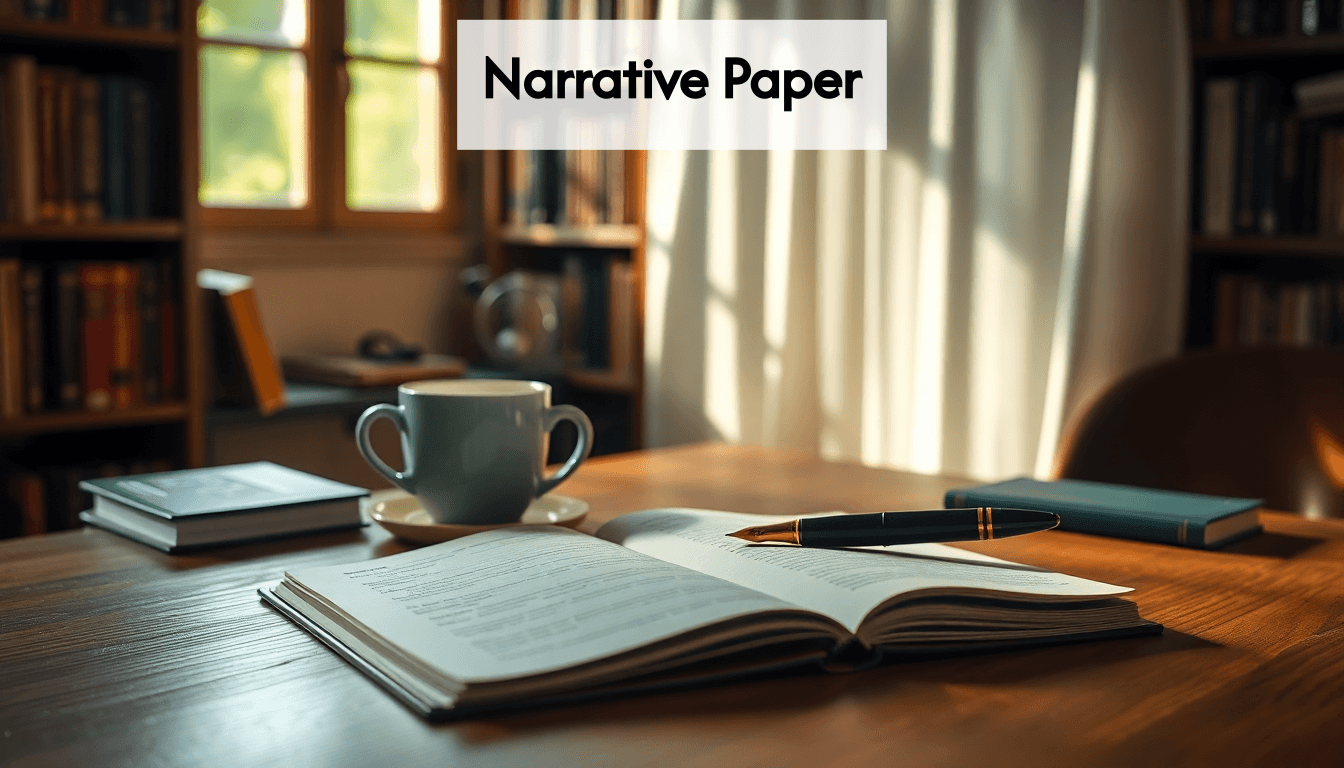Blog
Learning Materials
What is a Narrative Paper? A Clear, Simple Guide to Writing
Updated: April 1, 2025

What is a Narrative Paper? A Clear, Simple Guide to Writing

A narrative paper is more than a simple recounting of events; it’s an invitation for readers to step into your shoes and experience your journey. Surprisingly, many people think it’s simply about storytelling, but here’s the twist: the true power lies in the lesson behind your tale. By weaving personal insights into the fabric of your narrative, you transform everyday experiences into profound revelations that resonate with others.
Understanding a Narrative Paper
A narrative paper represents a unique form of academic writing where you share a story from your life or imagination while making a specific point. Unlike analytical or argumentative essays, narrative papers invite readers into your personal experiences through vivid storytelling techniques.
Core Elements of Narrative Writing
Every effective narrative paper contains several fundamental elements:
- Clear Central Theme - Your narrative needs a purpose beyond simply recounting events
- Reveals a personal insight or lesson learned
- Connects to universal human experiences
- Guides the selection of details and storytelling approach
- Compelling Characters - Well-developed individuals who drive the story
- Include physical descriptions and personality traits
- Show character motivations and conflicts
- Develop character arcs when appropriate
- Engaging Plot Structure - The sequence of events that builds tension
- Introduction (setting the scene)
- Rising action (building complications)
- Climax (the turning point)
- Resolution (the aftermath and meaning)
- Vivid Setting - The time and place where events unfold
- Incorporates sensory details (sights, sounds, smells)
- Creates atmosphere that enhances the story's emotion
- Grounds readers in specific locations and timeframes
Narrative Format vs. Other Essay Types
Understanding how narrative essays differ from other academic writing helps clarify their unique approach:
| Feature | Narrative Essay | Argumentative Essay | Expository Essay |
|---|---|---|---|
| Purpose | Tell a story with meaning | Persuade through reasoning | Explain information objectively |
| Voice | First-person perspective | Third-person perspective | Typically third-person |
| Content | Personal experiences | Evidence and logical arguments | Facts and explanations |
| Structure | Chronological storytelling | Thesis-driven organization | Topic-centered organization |
| Tone | Personal and reflective | Formal and persuasive | Informative and direct |
The narrative format gives you freedom to express your unique voice while still maintaining academic standards. This balance makes narrative essays particularly engaging for both writers and readers.
When You'd Write a Narrative Paper
Narrative papers appear in various academic and professional contexts:
- College admission essays where you share formative experiences
- English composition courses exploring personal writing
- Creative writing assignments developing storytelling skills
- Reflective assignments in fields like education, nursing, or social work
- Professional contexts like journalism or memoir writing
According to narrative research specialists, narrative writing isn't just about telling stories—it's a fundamental way humans construct meaning from experiences and claim identities. This makes the narrative form particularly powerful for exploring personal growth and understanding.
A well-crafted narrative paper transforms ordinary experiences into meaningful reflections. By sharing your unique perspective through a structured story, you invite readers to connect with universal themes while appreciating your individual journey. The narrative essay outline provides the framework, but your authentic voice brings the story to life and communicates its deeper significance.
Key Takeaways
| Takeaway | Explanation |
|---|---|
| Clear Central Theme | Your narrative should have a purpose that goes beyond just recounting events; it should reveal insights or lessons learned that connect with broader human experiences. |
| Vivid Descriptive Language | Use sensory details to create immersive experiences for the reader, showing emotions and actions rather than merely stating them. |
| Engaging Plot Structure | Organize your narrative using a clear structure that includes an introduction, rising action, climax, falling action, and conclusion to maintain logical progression. |
| Character Development | Portray well-developed characters whose motivations and transformations are evident, enhancing the overall authenticity of your narrative. |
| Strong Beginning and Ending | Start your narrative with an intriguing hook and end with a reflection on the significance of your story to leave a lasting impact on readers. |
Key Elements and Structure
A well-crafted narrative paper follows a specific structure while incorporating essential elements that bring your story to life. Mastering these components ensures your narrative not only engages readers but also effectively communicates your intended message.
Essential Components of a Narrative Paper
The foundation of any compelling narrative paper rests on these fundamental elements:
- Strong Narrative Thesis - Unlike argumentative essays, your thesis presents the central idea or lesson of your story
- States the purpose behind sharing this particular experience
- Often appears at the end of your introduction
- Guides the story's direction without explicitly announcing "This paper will show..."
- First-Person Perspective - Most narrative essays utilize "I" or "we" pronouns
- Creates immediacy and personal connection
- Allows readers to experience events through your eyes
- Provides direct access to your thoughts and feelings
- Chronological Organization - Events typically unfold in sequential order
- May incorporate flashbacks or flash-forwards when relevant
- Maintains clear temporal relationships between events
- Helps readers follow the story's progression naturally
- Descriptive Language - Sensory details that create vivid mental images
- Shows rather than tells ("My hands trembled" vs. "I was nervous")
- Incorporates specific sights, sounds, smells, tastes, and textures
- Creates an immersive experience for readers
Narrative Paper Structure
While narrative writing offers creative flexibility, following this proven structure will help organize your story effectively:
| Section | Purpose | Key Techniques |
|---|---|---|
| Introduction | Hook readers and establish context | Start with an intriguing question, surprising fact, or vivid scene |
| Background | Provide necessary context | Introduce relevant characters, settings, and circumstances |
| Rising Action | Build tension through complications | Present challenges and obstacles with increasing significance |
| Climax | Deliver the story's turning point | Focus on the moment of greatest emotional intensity or revelation |
| Falling Action | Show consequences of the climax | Demonstrate how events resolve and characters respond |
| Conclusion | Reflect on meaning and significance | Connect personal experience to broader insights without stating "In conclusion" |
Crafting an Effective Narrative Outline
Before writing your full narrative paper, creating an outline helps organize your thoughts and ensure a coherent flow. A basic outline format for a narrative essay includes:
-
Introduction
-
Opening hook to capture interest
-
Brief overview of the situation
-
Narrative thesis statement (the point of your story)
-
Body Paragraphs (organized chronologically)
-
First major event or scene with relevant details
-
Second major event or scene showing progression
-
Additional events building toward climax
-
Climactic moment with full sensory details
-
Resolution of main conflict or situation
-
Conclusion
-
Reflection on significance
-
Connection to broader meaning
-
Final thought that resonates
According to content structure experts, maintaining a clear organizational framework is essential, even in creative formats like narrative writing. While you have freedom to tell your story, readers still need logical progression to stay engaged.
Remember that narrative papers blend creative storytelling with academic purpose. Your structure should showcase your writing skills while ensuring readers can follow your story's progression and understand its significance. The narrative format provides flexibility, but maintaining these key structural elements helps transform personal experiences into meaningful academic writing.
Steps to Craft a Narrative Paper
Writing a compelling narrative paper involves more than simply recounting events. It requires careful planning, thoughtful execution, and meticulous revision. Follow these steps to create a narrative paper that resonates with readers while fulfilling academic requirements.
1. Choose a Meaningful Experience
The foundation of an effective narrative paper begins with selecting the right story to tell:
- Select an experience with a clear point - Avoid anecdotes that lack significance
- Consider experiences that taught you something - Personal growth moments make powerful narratives
- Look for stories with emotional depth - Experiences that stirred strong feelings often resonate with readers
- Ensure the experience fits assignment parameters - Check word count limits and topic requirements
When evaluating potential topics, ask yourself: "What did this experience teach me that others might find valuable?" The best narrative papers share universal insights through personal stories.
2. Develop Your Narrative Outline
Before writing, create a structured outline to organize your story:
- Map key events chronologically - Identify the logical sequence of your story
- Determine your starting point (often before the main action)
- Identify major turning points
- Plan your resolution and reflection
-
Identify important characters and settings - Note who and where matters to your story
-
Clarify your narrative thesis - Define the central message or lesson
-
Plan sensory details for each scene - Note specific descriptive elements to include
A detailed outline prevents meandering and ensures your narrative maintains focus throughout the writing process.
3. Craft an Engaging Introduction
Your introduction sets the tone and draws readers into your narrative:
- Open with a compelling hook - Start with dialogue, a vivid description, or a thought-provoking question
- Establish context efficiently - Provide just enough background information
- Introduce key characters - Help readers connect with important people in your story
- Signal the significance - Hint at why this story matters without revealing everything
- Present your narrative thesis - State or imply the central point of your story
According to experts in scientific storytelling, even academic narratives benefit from establishing context before presenting details—the same principle applies to personal narratives.
4. Write the Body with Vivid Details
The body of your narrative paper should immerse readers in your experience:
| Narrative Element | Purpose | Example Techniques |
|---|---|---|
| Scene Setting | Grounds readers in time and place | Specific sensory descriptions of environments |
| Character Development | Makes people in your story feel real | Revealing actions, dialogue, and reactions |
| Pacing | Controls emotional impact | Varying sentence length; expanding important moments |
| Conflict | Creates tension and interest | Showing internal struggles or external obstacles |
| Dialogue | Brings characters to life | Using realistic conversation that reveals character |
Remember to show rather than tell whenever possible. Instead of writing "I was nervous," describe "My hands trembled as I reached for the doorknob, my mouth suddenly dry."
5. Conclude with Reflection and Insight
A strong conclusion elevates your narrative from simple storytelling to meaningful reflection:
- Resolve the main events - Provide closure to the story's action
- Share your personal growth - Explain how the experience changed you
- Connect to universal themes - Link your personal story to broader human experiences
- Avoid introducing completely new information - Stay focused on the narrative you've developed
- End with a memorable final thought - Leave readers with something to consider
6. Revise and Polish Your Narrative
Revision transforms a rough draft into a polished narrative paper:
- Check narrative flow - Ensure events progress logically and coherently
- Eliminate unnecessary detours or confusing time jumps
- Add transitions between scenes when needed
-
Enhance sensory details - Add vivid descriptions where they're lacking
-
Refine dialogue - Make conversations sound natural and purposeful
-
Strengthen your narrative thesis - Ensure your point comes through clearly
-
Edit for clarity and concision - Remove unnecessary words and phrases
-
Proofread carefully - Eliminate grammar and spelling errors
The revision process often makes the difference between an average narrative paper and an exceptional one.
Crafting a narrative paper is both an art and a skill. By following these steps and investing time in each stage of the process, you'll create a narrative that not only tells your story effectively but also connects with readers on a deeper level. Remember that the most compelling narratives balance honest personal expression with careful attention to craft and structure.
Effective Narrative Writing Tips
While understanding the structure and elements of narrative papers is essential, mastering certain techniques can elevate your writing from good to exceptional. These practical tips will help you craft compelling narratives that engage readers while maintaining academic integrity.
Show, Don't Tell
The most powerful narrative writing creates vivid mental images rather than simply stating facts. Compare these approaches:
| Telling | Showing |
|---|---|
| "I was nervous about the interview." | "My palms dampened the resume in my hands as I counted each breath, trying to steady my racing heart." |
| "The beach was beautiful." | "Crystalline waves lapped against pristine white sand as gulls traced lazy circles in the cloudless azure sky." |
| "My grandmother was kind." | "Without a word, she slid an extra cookie onto my plate and winked, her eyes crinkling at the corners." |
Showing through sensory details and specific actions makes your narrative more immersive and convincing. It transforms abstract emotions into concrete experiences that readers can visualize and feel.
Develop Authentic Voice
Your narrative voice—the distinctive way you express yourself—creates connection with readers:
- Embrace your natural speaking rhythm - Write as if conversing with a friend while maintaining appropriate academic tone
- Read your writing aloud to ensure it sounds like you
- Avoid forced formality that feels unnatural
- Incorporate thoughtful reflection - Balance action with insight
- Include your thoughts and reactions to events
- Show your perspective changing as the narrative progresses
- Use dialogue strategically - Reveal character and advance the narrative
- Capture speaking patterns that feel authentic
- Avoid excessive dialogue tags beyond "said" and "asked"
According to writing experts, developing your unique voice comes from both reading widely and consistent practice. Your narrative voice evolves naturally when you write regularly and authentically.
Create Meaningful Conflict
Engaging narratives require tension to drive the story forward:
- Internal conflict - Struggles within yourself (fears, doubts, conflicting desires)
- Interpersonal conflict - Challenges between you and others
- Environmental conflict - Obstacles presented by circumstances or settings
Even in academic narrative papers, some form of conflict creates the necessary tension that makes your story worth reading. The resolution of this conflict often reveals the narrative's central insight or lesson.
Use Strategic Pacing
Controlling your narrative's rhythm affects how readers experience your story:
- Slow down crucial moments - Expand important scenes with detailed description
- Accelerate through less significant transitions - Summarize less important events
- Vary sentence length intentionally - Short sentences create urgency; longer sentences slow the pace
Effective pacing ensures readers focus on the most meaningful aspects of your narrative while maintaining engagement throughout.
Craft a Strong Beginning and Ending
The opening and closing of your narrative paper deserve special attention:
Beginning techniques:
- Start in medias res (in the middle of action)
- Open with intriguing dialogue
- Describe a vivid sensory scene
- Pose a thought-provoking question
Ending techniques:
- Circle back to reference your opening scene with new perspective
- Show how you've changed through the experience
- Share the lasting impact of the events described
- End with a memorable image or observation
Balance Description and Action
A compelling narrative alternates between showing what happened and creating atmosphere:
- Action moves the story forward - What occurred and how events unfolded
- Description creates immersion - How things looked, sounded, felt, tasted, smelled
Aim for a rhythm that blends these elements naturally. Too much description slows your narrative; too much action without context feels rushed and shallow.
Revise with Purpose
Effective revision transforms good narratives into great ones:
- First revision: Structure and content - Ensure your narrative flows logically and makes your point
- Second revision: Language and description - Enhance imagery and strengthen word choices
- Third revision: Technical aspects - Fix grammar, punctuation, and formatting issues
Allow time between drafts to gain perspective. Reading your work aloud helps identify awkward phrasing and rhythm problems that eyes alone might miss.
Implementing these techniques requires practice, but each strengthens your ability to craft meaningful narrative papers. Remember that effective narrative writing balances creativity with purpose—your personal story should ultimately reveal insights that resonate beyond your individual experience.
Avoiding Narrative Paper Pitfalls
Even experienced writers can fall into common traps when crafting narrative papers. Being aware of these potential pitfalls will help you create stronger, more effective narratives that fulfill both creative and academic requirements.
Losing Focus on Your Central Point
One of the most common mistakes in narrative writing is straying from your central thesis or message:
- Problem: Including interesting but irrelevant anecdotes or details
- Solution: Test each paragraph against your narrative thesis—if it doesn't support your central point, revise or remove it
- Prevention: Create a clear outline before writing and revisit it during the drafting process
Narrative papers aren't simply chronological accounts of events. Every scene, character, and detail should contribute to your overarching message or insight.
Overdoing Description
While descriptive language brings your narrative to life, excessive description can overwhelm readers:
| Balanced Description | Excessive Description |
|---|---|
| Selected details that reveal character or setting | Exhaustive descriptions that slow pacing |
| Sensory elements that enhance key moments | Paragraph after paragraph of environmental details |
| Descriptions that serve the narrative purpose | Flowery language that calls attention to itself |
Strike a balance between creating vivid scenes and maintaining narrative momentum. Each descriptive element should serve your story rather than distract from it.
Starting Too Early or Ending Too Late
Many narrative papers suffer from ineffective beginnings and endings:
- Starting problems:
- Beginning with unnecessary biographical background
- Opening with clichés like "Since the beginning of time" or "I'm going to tell you about"
- Including extensive setup before reaching the actual story
- Ending issues:
- Continuing past the natural conclusion point
- Adding a forced moral statement ("And that's why you should always...")
- Introducing new information in the conclusion
According to narrative essay experts, weak introductions significantly impact reader engagement. Start close to the main action and end when you've made your point—anything more dilutes your narrative's impact.
Neglecting Character Development
Even in personal narratives, characters (including yourself) need sufficient development:
- Flat characterization: Presenting people as one-dimensional figures
- Missing motivations: Failing to explain why people (including yourself) acted certain ways
- Inconsistent portrayal: Depicting characters differently throughout the narrative without explanation
Show the complexity of the people in your narrative through their actions, dialogue, and your observations of them. This creates more engaging, believable stories.
Telling Rather Than Showing
Though mentioned earlier, this pitfall deserves emphasis because it's so common:
- Problem: Stating emotions and conclusions directly ("I was devastated" or "It was the best day ever")
- Solution: Demonstrate feelings through physical sensations, actions, and specific details
- Example: Instead of "I was nervous," write "My voice caught in my throat as I fumbled with my notes, the paper crinkling loudly in the silent room"
Using Inauthentic Voice
Many writers adopt an artificial tone in academic writing that undermines narrative effectiveness:
- Overly formal language that creates distance between reader and writer
- Thesaurus syndrome where simple words are replaced with complex alternatives
- Passive voice overuse that drains energy from your storytelling
Your authentic voice—appropriately adjusted for academic context—creates a stronger connection with readers.
Failing to Provide Context
While your experience is familiar to you, readers need sufficient context:
- Assumed knowledge: Failing to explain relationships, settings, or background information
- Missing time markers: Not clarifying when events occur in relation to each other
- Unexplained significance: Not showing why certain moments matter to your narrative
Provide enough context for readers to understand your story without overwhelming them with unnecessary details.
Disregarding Academic Standards
Narrative papers blend personal storytelling with academic writing, requiring attention to scholarly standards:
- Formatting inconsistencies - Not following assignment guidelines for margins, spacing, citations
- Grammar and punctuation errors - Undermining credibility with technical mistakes
- Inappropriate language - Using overly casual expressions or slang
- Citation problems - Failing to properly attribute any outside sources
Remember that while narrative papers allow creative expression, they remain academic assignments with corresponding expectations.
By recognizing and avoiding these common pitfalls, you'll create narrative papers that effectively balance engaging storytelling with academic rigor. The most successful narrative essays maintain focus, use appropriate description, develop characters fully, and communicate authentically while meeting scholarly standards.
Frequently Asked Questions
What is a narrative paper?
A narrative paper is a unique form of academic writing that tells a story from the writer's life or imagination, focusing on conveying a specific point or insight through personal experiences.
What are the key elements of narrative writing?
The key elements of narrative writing include a clear central theme, compelling characters, an engaging plot structure, and a vivid setting all woven together to convey personal insights or lessons.
How does a narrative essay differ from other types of essays?
Unlike argumentative or expository essays, a narrative essay tells a story with personal experiences, often using a first-person perspective and a chronological storytelling structure, focusing on the writer's unique voice and insights.
When would I write a narrative paper?
You may write a narrative paper for various academic contexts such as college admission essays, creative writing assignments, reflective assignments in fields like education or nursing, or in professional contexts like journalism or memoir writing.
Unlock Your Narrative Paper's Potential with Samwell.ai
Feeling overwhelmed by the intricacies of crafting a compelling narrative paper? You're not alone. Many writers struggle with finding the right voice, developing engaging characters, and maintaining a clear focus throughout their story. The journey of transforming personal insights into a structured, meaningful narrative can feel daunting without the right tools.
So, how do you ensure your narrative resonates with readers while meeting academic standards?

Enter Samwell.ai! Our platform streamlines the process of writing your narrative paper by offering:
- Guided essay outlining to help you formulate your plot structure and central theme.
- Citation management tools that ensure you stay organized and academically compliant.
- Plagiarism checking and prevention, ensuring your work remains unique and above reproach.
Whether you’re writing a college admission essay or an impactful personal reflection, our advanced AI technology simplifies your writing journey. Don’t just tell your story—make sure it’s told in the most effective way possible! Join the ranks of over three million satisfied users who have crafted over 3.5 billion words with Samwell.ai. Start today at https://samwell.ai and elevate your narrative writing experience!
Generate essays with Samwell.ai
Whether you’re a publisher, professor, journalist, or student, let us tailor a plan just for you.Most Read Articles

Your Guide to Help Writing a Essay Successfully
Expert tips for help writing a essay - from crafting a thesis to structuring your essay effectively.

How to Write Critical Thinking Essay: Expert Tips
Expert tips for writing a critical thinking essay. Learn how to structure, choose topics, and use evidence effectively.'

How to Write a Good Hook: A Step-by-Step Guide
Master the art of crafting a good hook with our guide. Create compelling openers for a memorable first impression.

